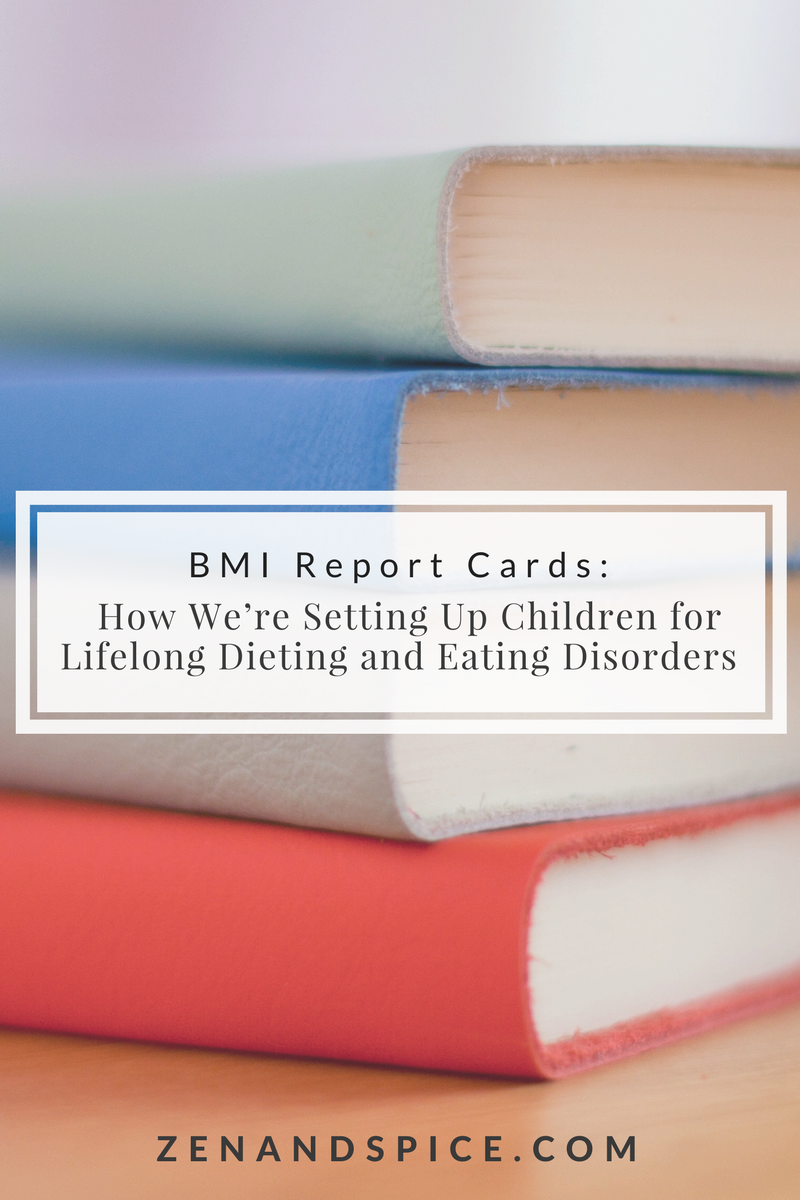
This week being National Eating Disorders Awareness Week, I wanted to chime in and highlight an issue I think is very important in eating disorder prevention. There is so much concern over children’s weight in this country — our government and the CDC are constantly sharing how the number of obese children has risen over the years and that children with obesity suffer from a variety of problems, including low self esteem, bullying and increased risk for chronic health conditions. Schools these days are inundated with various health and wellness programs and policies, all aimed at fixing the obesity epidemic.

I recently read an article about a school based intervention that over 50% of schools in our country are required to participate in: sending kids home with body mass index (BMI) report cards that emphasize the dangers of carrying excess weight. The article mentioned a recent study that showed parents are doubting the validity of these report cards — more than half of parents who got a report card did not believe it accurately categorized their child as underweight, normal weight, overweight or obese. These parents are onto something — not only are these anti-obesity campaigns ineffective, they’re dangerous.
Body mass index is an extremely unreliable measuring tool. It’s an archaic system. BMI was developed in the 1800’s by a Belgian scientist and used for assessing the collective weight of a population — not for assessing the health of an individual. BMI only takes into account weight and height, and does not include all the different body parts that influence weight, such as muscle or water retention. When BMI is applied to children, it’s equally as unreliable. BMI ranges for overweight and obese kids were randomly assigned based on what kids weighed years ago, without considering any current health data such as blood pressure, lipid levels, blood sugar, physical activity level etc.
The last thing kids need in today’s thin-obsessed world is more body shame. Yet, schools are sending children home with report cards on how “good” or “bad” the child is doing in regards to their weight and body size. Can you imagine the damage this could do to a young child? The heavy kids will likely be put on a restrictive diet and exercise regimens (that will set them up for a lifetime of diet cycling and possibly an eating disorder). Thin kids, who may have similar eating or inactivity habits, are ignored, because their weight is in the “healthy” range. Many children already deal with self esteem issues, and when you pile onto that body dissatisfaction, you walk the dangerous road to an eating disorder. A recent survey found that over 80 percent of 10 year olds are afraid of being fat, and over 50 percent of teenage girls engage in dangerous dieting behaviors (1).
Either way, categorized as “obese” or “normal”, all children who are exposed to fat fear-mongering increase their chance of partaking in disordered eating behaviors (as children and when they grow up into adults) and developing an eating disorder. Anorexia is commonly developed as puberty hits — when kids are in a very vulnerable place.

Our children are learning to live in fear of being or becoming fat. A focus on a child’s weight, whether it comes from a parent, doctor, school nurse or PE teacher, runs the risk of being very damaging. Showering kids with the dangers of future health problems doesn’t work either– this just scares children. The idea of future health problems is very abstract for children — and worrying about these problems won’t motivate behavior change. Feeling better physically in the moment has more impact.
We’re making fat the problem, when eating and activity habits have far more impact than weight does when it comes to determining how “healthy” a person is. It’s true that many of us in this country eat too many foods that don’t nourish us — and I am a firm believer that this is a direct result of our diet obsessed culture (and issues of social injustice, but that’s a whole other story). But the danger isn’t being fat. Our goal shouldn’t be to create thinner children — it should be to create healthier children! We can encourage healthy behaviors for what they are — creating healthy bodies and minds, not fighting fat.

People (adults and children alike) can be healthy in larger bodies. In fact, the large majority of children and adults aren’t meant to fit into the “normal” body size that diet culture emphasizes. Can we focus on eating well and being active for kids of all sizes — promoting health habits for their own sake — rather than fighting obesity? In a world where schools have access to dozens of wellness programs (some more directly addressing obesity than others), we need to be very careful about the messages we’re sending our children!
Children should be focused on building health and self esteem. Schools should drop BMI report cards and teach children how it feels good to nourish their bodies with a wide range of foods and to find movement they enjoy. Let’s teach our children the importance of body diversity: that humans come in a wide variety of shapes and sizes and are all deserving of love and respect!
- Mellin, L., McNutt, S., Hu, Y., Schreiber, G. B., Crawford, P., & Obarzanek, E. (1997). A longitudinal study of the dietary practices of black and white girls 9 and 10 years old at enrollment: The NHLBI growth and health study. Journal of Adolescent Health, 20(1), 27-37.




